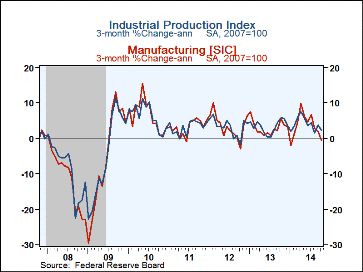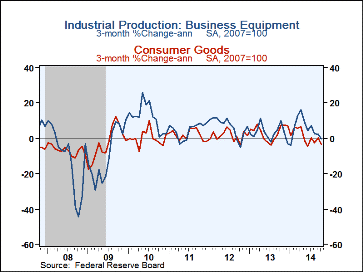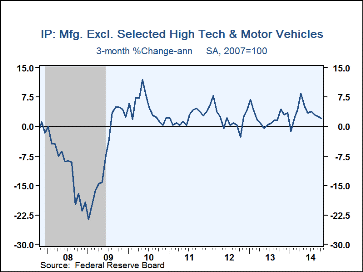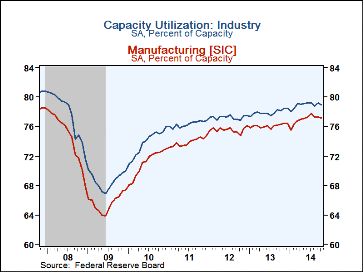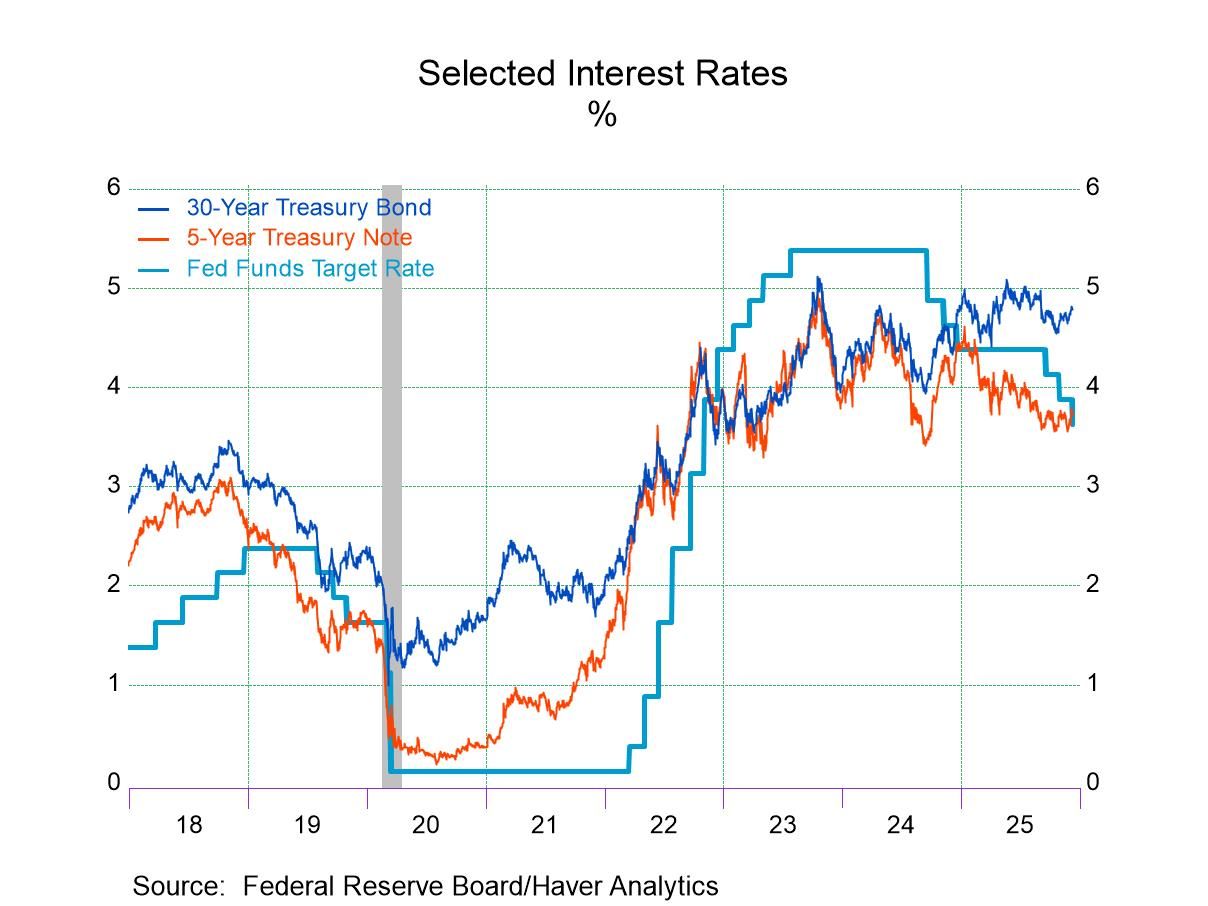 Global| Nov 17 2014
Global| Nov 17 2014U.S. Industrial Production Slips M/M as Forward Momentum Eases
by:Tom Moeller
|in:Economy in Brief
Summary
Industrial production slipped 0.1% last month following a 0.8% September increase, revised from 1.0%. Manufacturing sector production rose 0.2% (3.4% y/y) following a 0.2% September rise, last month reported as 0.5%. Despite the [...]
Industrial production slipped 0.1% last month following a 0.8% September increase, revised from 1.0%. Manufacturing sector production rose 0.2% (3.4% y/y) following a 0.2% September rise, last month reported as 0.5%. Despite the increase, three-month growth in production fell to -0.4% (AR). The October decline in total production was driven by a 0.8% drop (+9.9% y/y) in mining production and a 0.7% shortfall (-1.3% y/y) in utility output. A 0.2% gain in total production was expected in the Action Economics Forecast Survey.
Business equipment production led last month's factory sector gain with a 0.6% rise. It reflected a 1.3% increase (5.6% y/y) in machinery output and a 0.7% improvement (3.7% y/y) in computers & electronic products. Electrical equipment & appliance production dipped 0.4% (+2.8% y/y), the third decline in the last four months. Consumer goods production declined 0.2% as motor vehicle output fell 1.2% (+4.7% y/y) and paper production slipped 0.2% (-2.4% y/y). Offsetting these declines was a 0.6% rise (9.9% y/y) in furniture production. In the soft goods area, apparel production rose 0.7% (0.2% y/y) and chemical output increased 0.7% (4.2% y/y) as well. Petroleum & coal production ticked 0.1% higher (2.6% y/y).
Within the special aggregate series, high technology industries posted a 0.5% production gain (4.8% y/y) following four straight months of decline. The increase was driven by a 0.6% rise (6.6% y/y) in semiconductors. Computers & office equipment output fell 0.4% (-1.4% y/y). Factory sector production excluding the high-tech sector rose 0.2% (3.4% y/y). Manufacturing production excluding both high-tech and autos also gained 0.2% (3.2% y/y).
The capacity utilization rate fell to 78.9% and remained below the 80.5% high averaged in 2007. In the factory sector, the capacity utilization rate slipped to 77.2%, its lowest level since May. Total industry capacity rose an improved 3.0% y/y while factory sector capacity increased 2.1%.
Industrial production and capacity data are included in Haver's USECON database, with additional detail in the IP database. The expectations figure is in the AS1REPNA database.
Monetary Policy Accommodation, Risk-Taking, and Spillovers from the Federal Reserve Board is available here.
| Industrial Production (SA, % Change) | Oct | Sep | Aug | Oct Y/Y | 2013 | 2012 | 2011 |
|---|---|---|---|---|---|---|---|
| Total Output | -0.1 | 0.8 | -0.2 | 4.1 | 2.9 | 3.8 | 3.3 |
| Manufacturing | 0.2 | 0.2 | -0.5 | 3.4 | 2.7 | 4.1 | 3.3 |
| Consumer Goods | -0.2 | 0.4 | -1.0 | 1.4 | 2.4 | 1.7 | 1.5 |
| Business Equipment | 0.6 | -0.4 | -0.3 | 4.6 | 3.6 | 7.5 | 5.6 |
| Construction Supplies | 0.2 | 0.5 | -0.1 | 3.6 | 4.2 | 4.6 | 3.0 |
| Materials | -0.2 | 1.2 | 0.1 | 5.7 | 3.2 | 4.5 | 4.7 |
| Utilities | -0.7 | 4.2 | 0.8 | -1.3 | 2.1 | -2.1 | -0.2 |
| Capacity Utilization (%) | 78.9 | 79.2 | 78.8 | 78.2 | 78.0 | 77.3 | 76.3 |
| Manufacturing | 77.2 | 77.3 | 77.3 | 76.3 | 76.1 | 75.5 | 73.9 |
Tom Moeller
AuthorMore in Author Profile »Prior to joining Haver Analytics in 2000, Mr. Moeller worked as the Economist at Chancellor Capital Management from 1985 to 1999. There, he developed comprehensive economic forecasts and interpreted economic data for equity and fixed income portfolio managers. Also at Chancellor, Mr. Moeller worked as an equity analyst and was responsible for researching and rating companies in the economically sensitive automobile and housing industries for investment in Chancellor’s equity portfolio. Prior to joining Chancellor, Mr. Moeller was an Economist at Citibank from 1979 to 1984. He also analyzed pricing behavior in the metals industry for the Council on Wage and Price Stability in Washington, D.C. In 1999, Mr. Moeller received the award for most accurate forecast from the Forecasters' Club of New York. From 1990 to 1992 he was President of the New York Association for Business Economists. Mr. Moeller earned an M.B.A. in Finance from Fordham University, where he graduated in 1987. He holds a Bachelor of Arts in Economics from George Washington University.


